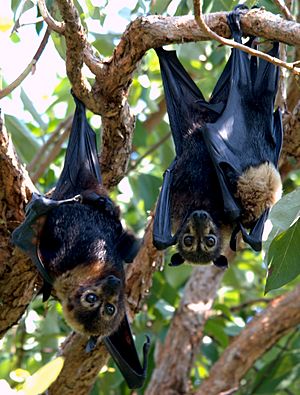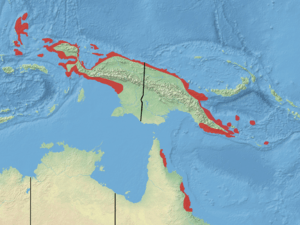Spectacled flying fox facts for kids
Quick facts for kids Spectacled flying fox |
|
|---|---|
 |
|
| Male, female, and their young | |
| Conservation status | |
| Scientific classification | |
| Genus: |
Pteropus
|
| Species: |
conspicillatus
|
 |
|
| Distribution of the spectacled flying fox | |
The spectacled flying fox (Pteropus conspicillatus), also known as the spectacled fruit bat, is a type of very large bat called a megabat. It lives in the north-eastern parts of Queensland, Australia. You can also find it in New Guinea and on islands nearby, like Woodlark Island, Alcester Island, Kiriwina, and Halmahera.
This amazing bat is listed as a threatened species because its population has dropped. This happened mainly because they lost their favorite places to find food and safe spots to rest. Sometimes, these bats drink water by skimming over the surface, and crocodiles can catch them. In 2020, the IUCN (a group that tracks endangered animals) said the species was endangered.
In 2019, the Australian government also changed its status from "vulnerable" to "endangered." This happened after a very hot heatwave in Queensland in late 2018. Nearly one-third of all spectacled flying foxes died during that heatwave.
Contents
What Does a Spectacled Flying Fox Look Like?
These bats are quite large. Their head and body are about 22 to 25 centimeters long. Their forearm (the main bone in their wing) is 16 to 18 centimeters long. They can weigh anywhere from 400 to 1000 grams.
A spectacled flying fox gets its name from the pale yellow or straw-colored fur around its eyes. This fur looks a bit like spectacles or glasses. They also have pale yellow fur across their back, neck, and shoulders. Some even have this light-colored fur on their face and the top of their head.
Where Do Spectacled Flying Foxes Live?
Spectacled flying foxes are forest animals. They especially love living in rain forests. They like to rest high up in the trees, where the sun can reach them.
You can find large groups of these bats, called colonies, in many different places. They live in rain forests, mangroves (which are coastal forests), and forests with paperbark and eucalypt trees. More and more, they are also being seen living near cities and towns.
What Do Spectacled Flying Foxes Eat?
The spectacled flying fox eats mostly fruits and flowers. Their natural diet includes fruits from rainforest trees. They also enjoy flowers from trees that grow near rivers.
They especially like flowers from trees like Eucalyptus and Syzygium species. They also eat fruits from fig trees (Moraceae family) and other Syzygium trees.
Life Cycle and Reproduction
Spectacled flying foxes usually have one baby each year. Female bats can start having babies when they are about one year old. Male bats probably don't start breeding until they are three or four years old.
They are polygamous, which means one male can mate with several females. In fact, there might be twice as many females as males in a colony. Babies are usually conceived between April and May. Females give birth to their single young between October and December.
Young bats are nursed by their mothers for more than five months. After they stop drinking milk, they gather in special "nursery trees" within the colony. As they get older, the young bats start flying out with the colony at night. They fly further and further, sometimes many kilometers away from the main colony. They are "parked" in nursery trees during the night and brought back to the main colony in the morning.
How Long Do Spectacled Flying Foxes Live?
In the wild, spectacled flying foxes usually live for about 12 to 15 years. However, if they live in zoos or special care, they can live for more than 30 years!
Some natural things that can cause them to die include being hunted by rufous owls and pythons. They can also get sick from paralysis ticks if they fly too close to the ground to eat. Sometimes, baby bats are born too early or have problems developing.
Sadly, many flying foxes also die because of human activities. They can get tangled in power lines, nets, or barbed wire fences. Because of these dangers, most wild flying foxes probably live shorter lives than they could.
Protecting Spectacled Flying Foxes
In 2012, the Queensland Government started allowing farmers and fruit-growers to get permits. These permits let them kill a small number of flying foxes to protect their crops. Before this, shooting bats was not allowed because it was seen as unkind to the animals.
In February 2019, the Australian Department of the Environment and Energy announced that the spectacled flying fox's national status was changing. It went from "vulnerable" to "endangered." This change happened because of very hot weather in the summer of 2018-19. These extreme heatwaves caused over 20,000 spectacled flying foxes to die. It's thought that about one-third of their entire population was lost during these heatwaves.
Gallery
See also
 In Spanish: Zorro volador de anteojos para niños
In Spanish: Zorro volador de anteojos para niños










